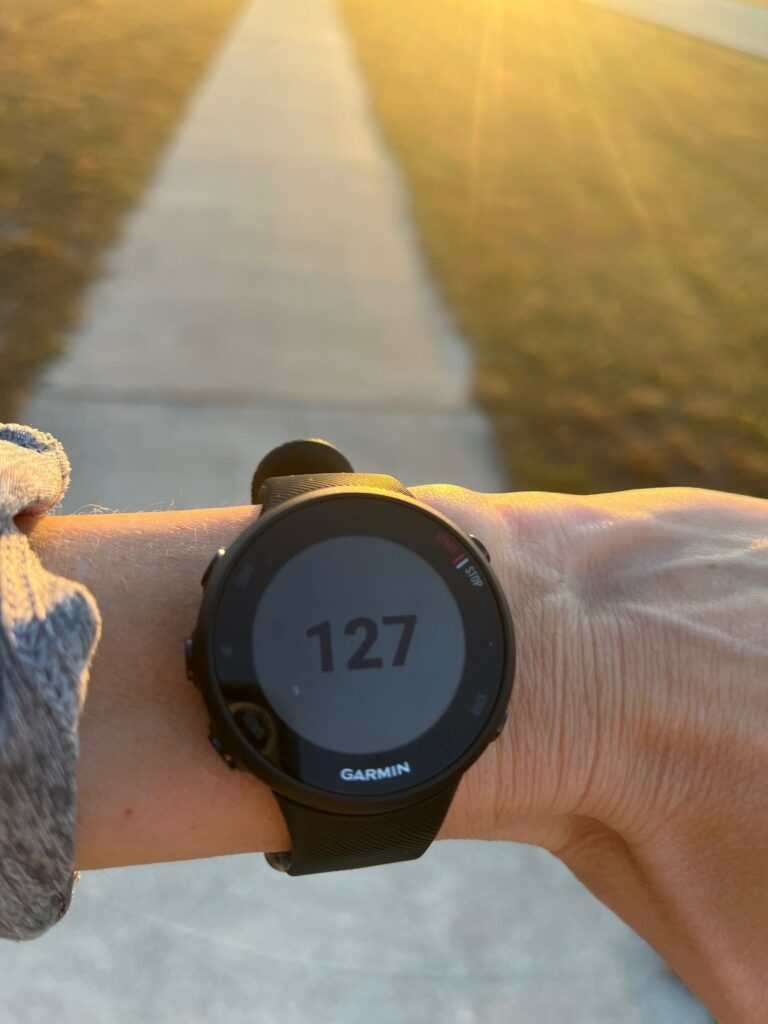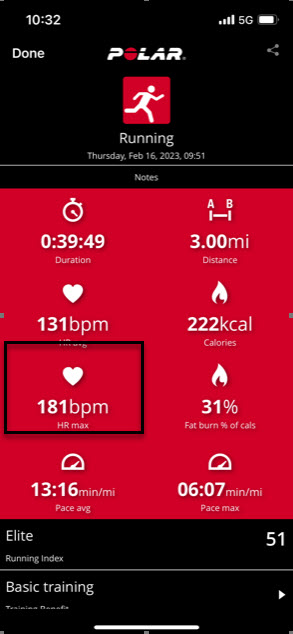
If you are a beginner runner, you can benefit from learning about heart rate monitors and not waiting like I did. This is the perfect time to learn the basics to help you decide if you need one, how to use one and which kind to choose, as well as what other more experienced runners say about them.
Heart rate monitors are a great tool beginner runners can use for motivation, tracking progress, and injury prevention. Although monitors are not necessary for running, they can enhance the experience and help you be more successful. While there are runners who don’t use them, most acknowledge there are benefits to using one.
Your heart rate is a great metric to monitor and analyze, especially when beginning a new exercise routine. While it can be a great addition, it is not necessary to start running. Learning the benefits of tracking your heart rate, how to choose the right monitor for you, and how to use a monitor in your workout are all basics you will want to become familiar. Read on for a simple breakdown and some additional helpful resources for learning the basics of heart rate training as a beginner.
Heart monitors cannot do the running for you

Running is hard work especially in the beginning. At a minimum you need a good pair of running shoes (see my article here on why you should invest in running shoes), but beyond, that running is all up to you.
Both children and adults from every walk of life can run and enjoy running without any special tools, equipment, or products. This is one of the greatest benefits of running, nearly anyone can get a full body workout that can be personally tailored to individual fitness levels.
If you are thinking of running or are new to running, the priority should be establishing a running routine that is within your fitness level. A heart rate monitor cannot do the running for you and your body will likely tell you before a monitor does when you need to slow down.
Do not put off beginning a running routine if you do not have a heart rate monitor. It is more important to gradually work yourself up to being able to run consistently and a heart rate monitor will not help much during this phase (see my article here on best way to start running).
Too much technology can be a distraction, and this can be true with it comes running. Many enjoy the freedom that running provides and being disconnected from the world and technology is part of that freedom.
Learning to simply go for a run without worrying about tracking metrics can be both liberating and enjoyable. Many enjoy running without extra gear, but there are many benefits to monitoring your heart rate.
Benefits of using a heart rate monitor in running

As a beginner runner, a monitor can help you get in tune with your body, dial in your workouts, and provide good feedback for when you may need to take it easy. This can help you optimize your running workouts while preventing overtraining injuries.
Below is a review of some of the many benefits of running and training with a heart rate monitor.
- Supports injury prevention
- Provides additional motivation
- Aids in recovery
- Improves performance
- Promotes Weight loss
Injury Prevention:
One of the main premises of using a heart rate monitor in a high impact sport like running is to not over-stress the skeletal and muscular system while training your aerobic system. Your cardiovascular fitness improves much faster than the skeletal and muscular fitness so it easy to run too hard or too much once you can run consistently for 30 minutes.
For beginner and even experienced runners, it can be difficult to judge the level of intensity you are training at. Most of us tend to run much faster and for much longer than we should. This can lead to longer recoveries, fatigue, burnout, and injury.
There is a fine line between laziness and fatigue. Even experienced runners have a difficult time knowing the difference. A heart rate monitor can be just the tool to help you know when it’s time to push yourself and when you may need more recovery.
Stress, dehydration, poor night’s sleep, heat, and other factors can elevate your heart rate. Running at a set pace regardless of how these factors are affecting your heart rate can put you at risk for injury.
Motivation:
Let’s face it, most gadgets are fun. Monitoring and tracking your heart rate can put a little extra spice in your workout, especially if you are a data nerd like me.
Tracking your progress over time can encourage you to keep up the routine. When you first start running you will rapidly improve and see great gains in your pace at nearly the same heart rate.
As you continue running and find your pace plateauing, heart rate training can give more structure and purpose to your runs. This in turn will keep you motivated for each run.
Recovery:
One of the main benefits of heart rate training is knowing when you need to push your body and when you need to back off. Depending on your personality and sensitivity to pain you could be running too hard when you should be having an easy run.
In addition to knowing when to slow down, a heart rate monitor will be a good indicator of when you may need an extra day off. As you get familiar with your normal resting heart rate, an elevated heart rate of 10 bpm or more is a good indicator you are overtraining and need more recovery.
Improving performance:
Your running performance can increase using target heart rate training runs. There is a delicate balance between getting a lot of aerobic base runs in and then doing some higher intensity speed work and threshold or tempo runs.
Most training plans and coaches use a variety of runs to help runners improve efficiency, endurance, and speed. Heart rate monitors really take the guess work out of the level of effort that is required for each of the different types of runs.
Besides helping you execute prescribed targeted runs more accurately, staying injury free is one of the best ways to see improvements. This all leads to being a consistent runner which is a key factor in athletic performance (see my article here).
How to use a heart rate monitor
A heart rate monitor can be used to simply monitor and track your workouts, or it can be used as the basis of your workout determining how fast or intense you run. You can optimize your training using a heart rate monitor so that hard workouts are hard enough and easy ones easy.
There are three main types of running workouts. Each workout is performed at a different exertion level referred to as zones. The zones represent ranges of percentages of your max heart rate. While different plans or apps may use more or less zones, the % of max heart rate ranges do not vary much for each of the different workouts.
| Heart rate zone ( 5 zone plan) | Cardio Workout | Run Type | % Max Heart Rate |
| 2 | Aerobic | Easy run / Long Run | 60% – 70% |
| 4 | At anaerobic threshold | Tempo Run/Threshold Run | 80% – 90% |
| 5 | HIIT training | Interval repeats/Speed Workout | 90%-100% |
You will need to know max heart rate or critical heart rate. There are various ways to determine your max heart rate. The max heart rate is used to determine your different exertion efforts also known as training zones.
How to calculate max heart rate (MHR)
There are various ways to calculate your max heart rate. Below or some of the most popular are below:
- Traditional MHR = 220 – Age
- Hunt formula = 211-(0.64 x age)
- Gulati formula for women = 206 – (.88 x age) (see article here )
- Field test: Warm up for 10 minutes. Perform 3 repeats running hard for 2-3 minutes and then resting 2-3 minutes. With each repeat increase the speed you run. After the last repeat check your max heart rate (there are many variations that can be done that are similar).
***FYI: It is much easier to go with the calculation rather than the field test! I just did the field test this morning and it was REALLY hard. I got a max reading of 181 (shown below), the Hunt formula based on my age would be 181. That’s close enough for me.

Over time you will likely notice improvements as you continue running. As a beginner you will see big improvements in running pace at the same heart rate in the first few weeks. This will slowly plateau, and improvements will be much slower after a few months.
Different plans, apps, and monitors will break up your heart rate into various zones ranging from 3 to 6. A max heart rate determines the relative heart rate ranges for each zone. These zones can be used to aid with weight loss, optimizing training, and to avoid overtraining.
What are the different kinds of heart rate monitors?
There are two main types of heart rate monitors that use different technology for reading your heart rate. One uses the electrical current of your heart and the other detects your pulse.
- Electrical: A chest strap uses electrical detection to track the electrical current of your heartbeat. This is generally known to be the most accurate type of heart rate monitor. As it sits on your chest there is not much to interfere with a good signal.
- Optical: Wrist and arm band devices use infrared light to track your pulse rate. It detects the expansion of your arteries as the heart pumps the blood through the arteries. These are not as accurate. See study here.
Pros and Cons of Electrical vs Optical
A chest strap heart rate monitor is the most reliable, but you will need to sync your monitor with an app on your phone to get the feedback while exercising. In addition, a chest strap can be less appealing for women as you need to position the strap directly under your sports bra.
Wrist worn devices are extremely convenient and can be used for other purposes. You may like a step counter, track your heart rate while sleeping, or listen to music during your run. While extremely convenient, keep in mind that they are not as accurate as many things can interfere with the small light reading your pulse.
I found my Fitbit always gives me inaccurate heart rate readings for the first 5-10 minutes of starting to run. I knew this because the numbers jumped really high and would eventually settle down after about 10 minutes. I eventually compared to a chest strap monitor which confirmed my suspicions.
Besides being inaccurate, I’ve noticed issues with sunny hot weather using my wrist heart rate monitor. I have difficulty being able to read wrist watches in full sun but I’m sure that is not an issue for all watches. Touchscreens can also be problematic with sweaty hands. This can be very frustrating as you get more serious with tracking your runs and heart rate.
How to choose the right heart rate monitor for you
Choosing the right heart rate monitor will come down to personal preference based on accuracy, convenience, multi-purpose needs, price, and comfort. Ranking these factors in order of importance based on your needs and goals is the first step.
Accuracy: Chest strap heart rate monitors are known to be the most accurate.
Convenience: Wrist or arm band heart rate monitors tend to be more convenient as a chest strap requires a little more preparation before running. Checking your heart rate while running is also more convenient.
Multi-purpose: Wrist smart watches with heart rate monitors are the Swiss knife of monitors but are also more expensive.
Price: Chest heart monitors are generally more affordable. They only track your heart rate and will need to sync with an app on your phone to see reading while running.
Comfort: Wrist heart rate monitors tend to be the most comfortable for most people.
Chest and wrist monitor considerations
If you already have a smart watch with a heart rate monitor than start tracking your runs with that and see how it goes. Be aware that they are not always accurate, but the vast majority of the time they will be displaying accurate information.
If you want to get serious about tracking and training according to your heart rate, then invest in a chest strap heart rate monitor. Polar is frequently rated high as a reliable and affordable chest heart rate monitor. Just be sure to order the correct size strap (go with the smaller size if you’re unsure).
I use the Polar H10. It has been reliable, and I’ve gotten a lot of use out of it. Extra straps can be bought separately so need to worry if you order the wrong size. It works off a battery similar to ones used in car flobs.
I always take my phone with me and have the chest strap reading readily available with an app on my phone to get instant feedback. The only drawback with not using a wrist monitor is I’m constantly looking at phone to keep in a training heart rate zone.
To solve the above problem with chest straps, I will frequently wear a wrist heart rate monitor. For many years I used a Fitbit as I liked to be able to track other metrics like daily step, sleeping heart rate, etc.
For wrist worn heart rate monitors, choose wisely. I first chose a Fitbit because of it’s price but had a lot of issues on my runs (described earlier). Garmin is traditionally the king of watches for runners, and they continue to uphold their high reputation. For an affordable and highly ranked heart rate monitor watch see below.
For more information on watches check out the article here for the best heart rate monitors of 2023.
What others are saying about heart rate monitors and running
It is interesting to note what others in the running community are saying about the use of heart rate monitors in running. A newer runner posed the below question, and the responses were quite interesting.
How important is a heart rate monitor? : running (reddit.com).
| Poll: how important is heart rate monitor for runners | Respondents from runners |
| Not important | 6 |
| Nice to have | 3 |
| A great tool (makes a difference) | 10 |
| Noncommittal | 2 |
| Total Comments | 21 |
Some of the comments from the ones who thought they were a great tool included:
- Vital for performance
- Use for pacing to focus on exertion levels rather than time
- The most important and easiest metric to track
- Excellent for telling you your overtrained
- Good training assistance as it shows your real form
- Excellent as helps you become fitter
Of the 2 that commented it was nice to have, the one noted the benefit for beginner runners to them help get the feel of things. This comment makes a good point for beginners as they often need more feedback about their body when beginning a new exercise routine.
The bottom line is to do what will work for you. If tracking metrics will help keep you motivated, help optimize your training, or aids in knowing your overtraining than a heart rate monitor may be just the tool for you.
Key Takeaways
If you don’t currently have a heart rate monitor don’t let that prevent you from running. It is not necessary for running and you can still run successfully without one.
They can be a great tool to support your running with many benefits that new and experienced runners enjoy. Determining if using a heart rate monitor is right for you is a personal choice but remember that a monitor can’t do the running for you.